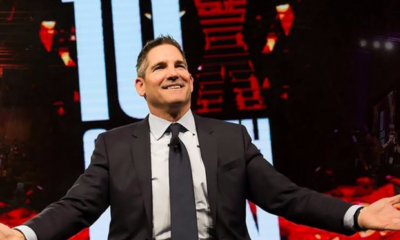Success Advice
How To Become A Millionaire Author

Writing a book is one of those experiences where simply just creating your own book is a reward in itself. But there is nothing wrong with wanting to be a major success either. We always hear breakthrough stories about authors like Stephen King, Nicholas Sparks, Stephenie Meyer, or J.K. Rowling who become overnight successes and very wealthy.
If you want to become a successful author then here are some steps that must be taken in order to achieve that goal. Keep in mind that the road to mainstream success is a varied one, but these principles should apply to every writer who wants success.
The Steps Of A Successful Author
The first thing you need to know is that you MUST hone your craft. You wouldn’t try to sell paintings if the only thing you know how to draw is a stick figure would you? Writing is an art just like any other, so you need to develop your craft as much as possible. This means experimenting with different writing styles, figuring out how you approach subject matter, and most importantly developing your professional tone. A mastery of the language you write in is vital. It is only when you know the rules of language that you can break them.
While mastering your craft it is also a good idea to find the best audience that fits your genre and begin to build a following. Publishing has changed a lot over the past ten years with the internet becoming an increasingly viable (and often necessary) means of gaining success. Using online writing sites where users give feedback will not only help you build up readers, but it will give you an idea of what readers are looking for.
One of the keys to becoming a successful author is finding the right balance between meeting commercial imperatives without compromising your vision as an author. After all, success is not worth much if you think of yourself as a sell-out. You need to remember that no author gains success by playing it safe.
J.K. Rowling is a prime example of an author who gives her fans what they want while sticking to her creative guns and throwing in great twists that readers did not see coming. Remember that you attain success and fans as a result of your creativity. On the other side of that coin it cannot hurt to know what your audience wants, so long as you do not fall into the trap of constant fan service. It may seem to be a situation where you are trying to have your cake and eat it as well, but it is a balance that every author must work towards striking.
Developing the ability to write quickly is also vital. While it is most important to get your book right as you writing it, when you are trying to get it published time is of the essence, especially if you have a book deal. Learning to write under the pressure of a deadline will also help to make you a more productive writer, and if you can write quickly as well as write well then you are more desirable to publishers and worth their investment in you.
One of the most difficult steps to becoming a successful author is actually getting your book published. There are several steps you can take to become published, but none of them are exactly easy. E-books are becoming increasingly popular, but because of the lack of expense that goes into them the market is heavily saturated. Another form is self publication, this takes a little bit of cash initially but a number of authors have proven that this method is becoming more of a promising option.
Another option that many find helpful is to submit your work to a publishing house. You could even find an agent to do this for you, there are plenty agents out there, if you have the quality and they believe in you then they will get your work to the right publishing house for you. Just know that this process can be a little longer and you may find it frustrating. Don’t be discouraged if you receive a rejection letter as there are many authors who wrote best selling works that were turned down multiple times before finally landing a book deal.
NY Times best selling author Robert Kiyosaki, the author of ‘Rich Dad, Poor Dad’ had his ‘Rich Dad, Poor Dad’ book turned down by every publisher he approached and Barnes & Noble refused to stock his work initially. He decided to self publish the book and has sold over 26 million copies. This goes to show that you CAN make it happen by yourself, if you have quality work then others with promotional power ie.. Celebrities, Talk Shows, Radio Shows etc… Will spread the word of your amazing book which should in turn give you the leverage needed to move units.
Just remember, if you don’t self publish and you are going through a publishing house, be careful not to give away all your rights in your rush to get published. Take your publishing contract to an experienced lawyer who can explain all the terms before you decide to sign.
While being a well known author may seem like it should be easy enough once the big bucks are rolling in you need to keep in mind that fame won’t last without a solid building block to hold it up. The last thing you want to be is an author that is huge one day and gone the next. Whether you reach this stability through multiple sequels or through a just one timeless work of art it is completely up to you so long as you do eventually reach it in the end.
Checkout our article The Top 10 List Of The Highest Paid Authors to see how much a successful author really makes.
Article By: Coty Ellis | Addicted2Success.com
Success Advice
Best Interac Casinos Canada 2025 e-Transfer Casino Sites
Best Interac Casinos Canada 2025 e-Transfer Casino Sites
Premium Interac casinos offer 24/7 payment processing, reducing wait times for night-time withdrawal requests. Existing players are included as there’s a juicy loyalty program. Also, eligible players have a 100% match bonus on the first four deposits. This predominantly varies depending on the casino you’re playing with. The sites we recommend on this page offer reliable assurance that your money and details are secure. This is standard for all casinos and if this is not required, it should be a red flag.
Interac Online Casino Withdrawals
Interac uses the same banking system, which means you can get the same level of security. If they do, we immediately go to the banking section and look for the Interac banking logo. That’s worthy of note because the banking limits for these options might differ. Interac is generally a great way to pay when it comes to casinos. Only those Interac casinos that focus on good customer service make the cut.
What we don’t like about Playzilla:
The first deposit is matched up to $400, and the second and third are matched up to $300. One of the most appealing features on the site is the welcome bonus. Each deposit earns you a match deposit bonus that can earn you up to $1500. We’re also big fans of the VIP program that rewards existing players for their loyalty. The whole process of making the gambling deposit in one of your favorite Interac online casinos will take about ten minutes. If you are looking for a native Canadian solution for the casino deposit, here is a perfect option.
List of Casinos in Ontario
We recommend using any of the online casinos we mentioned in the sections above. Since these are top banks which are standing behind Interac it is a completely safe online payment service. As you will see from our review if you choose Interac payment can be made in a safe and convenient way. One can use this https://www.scoobynet.com/group.php?&do=discuss&groupid=89&discussionid=1328 banking method in some of the best online casinos in Canada to make deposits as well as to withdraw money. Instadebit is also a popular payment method at Interac casinos Canada.
Set a Gambling Budget
.png)
We are lucky as Canadians to have the choice to gamble, whether it is with online casinos in Canada or land based ones. We here at Casino Canuck have been gambling long before online casinos even existed. Most casino sites require a minimum deposit of $10, while some accept as low as $5. Bank transfers are widely available at real money gambling sites.
Top Games Available At Interac Online Casinos
See if the online casino has optimised its games and interface for Android and iOS users. After a successful debut in 2025, Fast Slots Casino has become a favourite among Canadian players. Operating with a Curaçao licence, the brand is subject to strict regulatory oversight, which ensures fair gameplay and secure payments for players. Our Del Oro review provides in-depth insight into the casino site to help you understand the platform. Use Interac to set clear bankroll boundaries — treating transfers as a single session budget can help avoid chasing losses.
The games these providers offer are safe and loaded with cutting-edge graphics, innovative gameplay and deep mechanics. If Interac payments are not protected properly, the review stops there. Canadian casinos need from 24 to 72 hours to verify your withdrawal request. Check its promotions page, and bonus terms and conditions, to see if such a feature is available. Firstly, if you make a minimum deposit, some games may not be available to you simply because of the minimum bet size limits. As soon as Interac casinos Canada process the request, they pass it to Interac.
Online gambling is legal when operated by provincial governments or through licensed operators. In Ontario, for example, casinos must be licensed by AGCO and operate under iGaming Ontario. Always choose casinos with verifiable licensing for the best protection and safety.
Success Advice
How Modern Technology Shapes the iGaming Experience
How Modern Technology Shapes the iGaming Experience
The iGaming industry has evolved rapidly over the last decade, driven by innovations in software, regulation and player expectations. Operators now compete not only on game libraries and bonuses but on user interface quality, fairness, and mobile-first delivery. A sophisticated approach to product design and customer care is essential for any brand that wants to retain players and expand into new markets.
Partnerships and platform choices influence every stage of the player journey, from deposit to withdrawal. Forward-thinking companies integrate cloud services, APIs and analytics to deliver smooth sessions and responsible play tools. Many leading vendors and enterprise providers offer comprehensive ecosystems that reduce latency, support multi-currency wallets and enable fast scalability, which can be complemented by services from large tech firms like microsoft
to manage infrastructure and compliance reporting.
Player Experience and Interface Design
Design matters. A streamlined onboarding process, clear navigation and quick load times increase retention. Modern casinos emphasize accessibility, offering adjustable fonts, color contrast options and straightforward account recovery flows. Mobile UX is especially critical; touch targets, responsive layouts and intuitive controls make sessions enjoyable on smaller screens. A strong visual hierarchy and consistent microinteractions also reinforce trust and encourage exploration of new titles.
Security, Compliance and Fair Play
Trust is the currency of iGaming. Encryption standards, secure payment gateways and transparent RNG certifications reassure players and regulators alike. Operators must implement KYC processes, anti-fraud monitoring and geolocation checks to comply with jurisdictional rules. Audits and certification by independent labs provide credibility, while continuous monitoring of suspicious behavior supports safer ecosystems.
Key Compliance Components
● Identity verification and age checks
● Secure payment processing and AML controls
● Random number generator audits
● Data protection aligned with regional law
Game Variety and Supplier Strategy
Players expect variety: slots, table games, live dealers, and novelty products like skill-based or social games. A balanced supplier mix helps operators cater to diverse tastes and manage risk. Exclusive content and localised themes drive loyalty in specific markets, while global hits maintain broad appeal. Integration frameworks and content aggregation platforms permit rapid expansion of libraries without sacrificing quality control.
Responsible Gaming and Player Protection
Responsible gaming tools are central to a sustainable business model. Time and stake limits, self-exclusion options and reality checks reduce harm and improve long-term retention. Data analytics spot at-risk behaviors early, allowing tailored interventions that protect both players and brand reputation. Transparent communication about odds and payout rates further strengthens the relationship between operator and player.
Performance Optimization and Analytics
Analytics transform raw telemetry into actionable insights: session length, churn triggers, funnel drop-offs and lifetime value projections. A/B testing frameworks help iterate lobby layouts, bonus structures and onboarding flows. Low-latency streaming for live dealer games and CDN strategies for asset delivery ensure consistent quality across regions. Strategic monitoring of KPIs guides investments in UX, marketing and content procurement.
Essential Metrics to Track
|
Metric |
Why It Matters |
|
Conversion Rate |
Measures onboarding effectiveness and first-deposit success |
|
Retention Rate |
Indicates long-term engagement and product stickiness |
|
ARPU / LTV |
Helps assess monetization and marketing ROI |
|
Load Time |
Impacts bounce rates, particularly on mobile |
Tactical Tips for Operators
Small changes can yield big lifts. Implement progressive onboarding, personalise offers based on behavior, and localise content and payment methods for each market. Prioritise server uptime and invest in customer support channels that include live chat and social messaging. Finally, maintain a strict approach to compliance while experimenting with gamification that enhances rather than exploits player engagement.
As technology advances, operators that combine user-centric design, robust security and data-driven decision making will lead the market. The most successful brands treat responsible gaming as a core value and leverage partnerships, platform automation and analytics to create compelling, safe experiences that stand the test of time.
Success Advice
Psychologia wygranej: jak emocje wpływają na decyzje graczy
Świat kasyn to nie tylko świat rozrywki i szansy na wygraną, ale także przestrzeń intensywnych emocji. Każdy gracz doświadcza mieszanki ekscytacji, adrenaliny i napięcia, które wpływają na podejmowane decyzje. Zrozumienie psychologii wygranej pozwala lepiej kontrolować emocje, planować strategie i podejmować świadome zakłady.

Jak emocje kształtują decyzje podczas gry
Emocje są jednym z najważniejszych czynników wpływających na decyzje graczy. Chęć natychmiastowej wygranej, strach przed stratą czy poczucie satysfakcji po sukcesie mogą powodować impulsywne zakłady lub przeciwnie — zbyt ostrożną grę. Psychologowie podkreślają, że kontrola nad emocjami jest kluczowa dla długofalowego sukcesu w kasynie.
Logowanie i komfort gry w kasynach online
W świecie gier online proces logowania ma ogromny wpływ na doświadczenie gracza. Intuicyjne i szybkie ice casino logowanie pozwala natychmiast rozpocząć sesję, minimalizując stres związany z technicznymi aspektami platformy. Dzięki temu gracz może w pełni skupić się na emocjach związanych z grą, analizie ryzyka i podejmowaniu decyzji strategicznych. Dodatkowo kasyna online oferują narzędzia wspierające graczy, takie jak historia wyników, statystyki i bonusy, które pomagają w świadomym planowaniu zakładów.
Tabela: Wpływ emocji na typowe decyzje gracza
| Emocja | Typowe zachowanie | Potencjalny wpływ na wygraną |
|---|---|---|
| Ekscytacja | Zakład większej kwoty | Może zwiększyć potencjalną wygraną, ale też ryzyko straty |
| Strach | Unikanie ryzykownych zakładów | Ogranicza możliwości, zmniejsza szanse na wygraną dużą sumę |
| Satysfakcja po wygranej | Kontynuacja gry w tym samym stylu | Może prowadzić do impulsywnych decyzji |
| Frustracja po przegranej | Próba „odrobienia strat” | Zwiększa ryzyko podejmowania nierozważnych zakładów |
Strategie kontrolowania emocji w grze
Aby emocje nie przejęły kontroli nad decyzjami, gracze mogą stosować różne strategie:
-
Planowanie budżetu na sesję i trzymanie się go
-
Wykorzystywanie narzędzi analitycznych dostępnych online
-
Stosowanie przerw w trakcie gry, aby ocenić swoje decyzje
-
Korzystanie z bonusów i promocji w sposób przemyślany
-
Świadome monitorowanie poziomu adrenaliny i emocji podczas gry
Podsumowanie
Psychologia wygranej pokazuje, że emocje w kasynie mają ogromny wpływ na decyzje graczy. Świadome zarządzanie swoimi reakcjami, korzystanie z narzędzi analitycznych oraz strategii pozwala czerpać satysfakcję z gry, minimalizując impulsywne zachowania i niekontrolowane ryzyko. Dzięki platformom online, takim jak ice casino, gracze mogą w komfortowych warunkach rozwijać swoje umiejętności, obserwować statystyki, korzystać z bonusów i podejmować przemyślane decyzje, które zwiększają szanse na sukces i pozytywne doświadczenia z gry.
Success Advice
Kiedy liczby zaczynają kierować emocjami
Na pierwszy rzut oka hazard wydaje się światem opartym wyłącznie na matematyce. Procenty, kursy, statystyki i algorytmy tworzą ramy każdej gry. Jednak za tym uporządkowanym światem liczb kryje się coś znacznie bardziej złożonego — emocje gracza, które często przejmują kontrolę w kluczowych momentach rozgrywki.

Liczby w kasynie nie są neutralne. Każdy współczynnik, każda wyświetlana wartość wpływa na sposób myślenia i odczuwania. Informacja o możliwej wygranej potrafi wywołać ekscytację, a seria przegranych — frustrację lub chęć szybkiego odegrania się.
Mechanika liczb a reakcje psychologiczne
Gdy gracz widzi konkretne wartości — wysokość stawki, potencjalną nagrodę czy procent zwrotu — jego umysł automatycznie próbuje nadać im znaczenie. Nawet osoby, które nie analizują statystyk na co dzień, reagują emocjonalnie na zmieniające się cyfry. To one budują napięcie i poczucie ryzyka.
Nowoczesne platformy, takie jak ice casino, prezentują dane w sposób czytelny i dynamiczny, co wzmacnia wrażenie kontroli. Paradoksalnie im więcej informacji otrzymuje gracz, tym łatwiej może ulec emocjom zamiast chłodnej kalkulacji.
Dlaczego liczby potrafią wciągać
Człowiek ma naturalną tendencję do szukania wzorców. W hazardzie przejawia się to w analizowaniu serii wyników i próbach przewidywania kolejnych zdarzeń. Nawet losowe sekwencje zaczynają wydawać się logiczne, co wzmacnia zaangażowanie i emocjonalne przywiązanie do gry.
Każda kolejna decyzja staje się odpowiedzią na liczby, które pojawiły się wcześniej. W ten sposób matematyka przestaje być tylko narzędziem, a zaczyna oddziaływać na psychikę gracza.
Równowaga między analizą a emocjami
Świadome podejście do gry polega na zrozumieniu, że liczby są elementem systemu, a nie obietnicą wyniku. Emocje pojawiają się naturalnie, jednak ich kontrola pozwala zachować dystans i podejmować bardziej racjonalne decyzje.
Aby lepiej zobrazować różnicę między chłodną analizą a emocjonalną reakcją, warto spojrzeć na poniższe zestawienie:
| Element gry | Podejście racjonalne | Reakcja emocjonalna |
|---|---|---|
| Wysokość stawki | Dopasowana do budżetu | Zwiększana pod wpływem impulsu |
| Seria przegranych | Przerwa lub zmiana strategii | Chęć natychmiastowego odegrania |
| Potencjalna wygrana | Ocena ryzyka i prawdopodobieństwa | Ekscytacja i nadmierny optymizm |
| Czas trwania sesji | Zaplanowany z góry | Przedłużany pod wpływem emocji |
Świadomość jako klucz do kontroli
Gdy gracz rozumie, w jaki sposób liczby wpływają na jego emocje, zyskuje przewagę nad impulsywnymi decyzjami. Hazard przestaje być chaotycznym doświadczeniem, a staje się formą rozrywki opartej na samokontroli i refleksji.
Ostatecznie to nie liczby rządzą grą, lecz sposób, w jaki człowiek na nie reaguje. Świadomość tego mechanizmu pozwala zachować równowagę między emocjami a rozsądkiem — a to właśnie ona decyduje o jakości całego doświadczenia.
-

 Did You Know4 weeks ago
Did You Know4 weeks agoThe Success Patterns You Inherited (And Didn’t Notice)
-

 Entrepreneurs3 weeks ago
Entrepreneurs3 weeks agoThe Essential Skills Every Entrepreneur Needs In 2026
-

 Business4 weeks ago
Business4 weeks agoThe Hidden Money Pit in Your Operations (and How to Use It)
-

 Change Your Mindset3 weeks ago
Change Your Mindset3 weeks agoHow to Turn Your Mind Into Your Greatest Asset (Instead of Your Enemy)
-

 Change Your Mindset2 weeks ago
Change Your Mindset2 weeks agoThe Silent Skill That Makes People Respect You Instantly
-

 Life2 weeks ago
Life2 weeks ago10 Research-Backed Steps to Create Real Change This New Year
-

 Tech2 weeks ago
Tech2 weeks agoWhat’s in a Name? How to Get Your Domain Right
-

 Did You Know1 week ago
Did You Know1 week agoHow Skilled Migrants Are Building Successful Careers After Moving Countries

























9 Comments